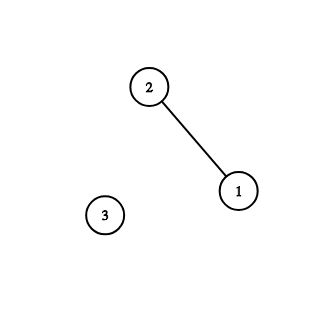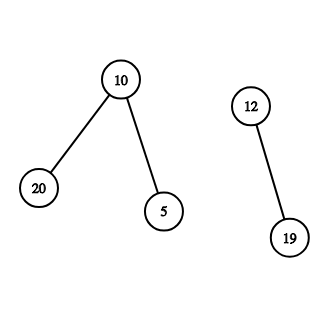You are given a set of size $m$ with integer elements between $0$ and $2^{n}-1$ inclusive. Let’s build an undirected graph on these integers in the following way: connect two integers $x$ and $y$ with an edge if and only if $x \& y = 0$. Here $\&$ is the bitwise AND operation. Count the number of connected components in that graph.
Input
In the first line of input there are two integers $n$ and $m$ ($0 \le n \le 22$, $1 \le m \le 2^{n}$).
In the second line there are $m$ integers $a_1, a_2, \ldots, a_m$ ($0 \le a_{i} < 2^{n}$) — the elements of the set. All $a_{i}$ are distinct.
Output
Print the number of connected components.
Examples
input
2 3
1 2 3
output
2
input
5 5
5 19 10 20 12
output
2
Note
Graph from first sample:

Graph from second sample:

Solution:
#include <bits/stdc++.h>
using namespace std;
int main() {
ios::sync_with_stdio(false);
cin.tie(0);
int n, m;
cin >> n >> m;
vector<int> was(1 << n, 1);
for (int i = 0; i < m; i++) {
int x;
cin >> x;
was[x] = 0;
}
vector<int> used(1 << n, 0);
vector<int> que(1 << n);
vector<int> inner(1 << n);
int ans = 0;
for (int start = 0; start < (1 << n); start++) {
if (was[start]) {
continue;
}
ans++;
was[start] = 1;
que[0] = start;
int qs = 1;
for (int q = 0; q < qs; q++) {
int u = (1 << n) - 1 - que[q];
if (!used[u]) {
used[u] = 1;
inner[0] = u;
int is = 1;
for (int i = 0; i < is; i++) {
int z = inner[i];
if (!was[z]) {
was[z] = 1;
que[qs++] = z;
}
for (int bit = 0; bit < n; bit++) {
if ((z & (1 << bit)) && !used[z ^ (1 << bit)]) {
used[z ^ (1 << bit)] = 1;
inner[is++] = z ^ (1 << bit);
}
}
}
}
}
}
cout << ans << '\n';
return 0;
}
Related posts:
Alex and a TV Show
New Year and Social Network
Landmarks
Stars and bars
Correcting Mistakes
Pie Rules
Beautiful fountains rows
Marbles
Tree Factory
Cunning Gena
Minus and Minus Give Plus
Prefix-Suffix Palindrome (Easy version)
Bear and Destroying Subtrees
Calculating the determinant of a matrix by Gauss
New Year and Forgotten Tree
Largest Submatrix 3
Pumping Stations
Carrot Cakes
Book of Evil
Longest Saw
Almost Same Distance
More Reclamation
Wilbur and Swimming Pool
Biridian Forest
Cow and Vacation
Kuroni and Impossible Calculation
Playing with Permutations
Snake
Walk on Matrix
Tanya and Password
Neural Network country
Intersection Point of Lines

